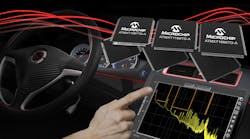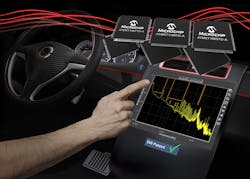Capacitive-Touch Controllers Speed EMI Qualification of Auto Touchscreens
To address electromagnetic-interference (EMI) and electromagnetic-compatibility (EMC) challenges faced by developers of automotive touchscreens, Microchip Technology launched three new maXTouch touchscreen controllers. The TD series features a new and differential mutual-signal-acquisition method that’s said to significantly increase signal-to-noise ratio (SNR). This allows the use of very thick glass or plastic cover lenses and multi-finger thick gloved touch support up to the equivalent of 4.5 mm of polymethyl methacrylate (PMMA).
The MXT1067TD, MXT1189TD, and MXT1665TD devices are optimized for 9- to 13-inch automotive touchscreens. They’re complemented by the recently introduced MXT449TD, MXT641TD, MXT2113TD, and MXT2912TD devices, which support up to 20-inch touchscreens. Each device addresses aspects of the increasing demand for functional safety features and is designed in accordance with the Automotive SPICE Level 3 capability and ISO 26262 Automotive Safety Integrity Level (ASIL) B requirements.
Microchip’s maXTouch enables designers to successfully combat various sources of electromagnetic interference such as:
• Injected current noise
• Display radiated noise
• Backlight and motor radiated noise
• Fast transient current
The maXTouch devices are built on a highly parallel sensing architecture and carry multiple hardwired analog and digital filters. Combined with a CPU core, maXTouch devices are able to maintain a fast reporting rate and excellent touch performance in the presence of severe electromagnetic noise sources, according to Microchip. In addition, all maXTouch devices are designed to meet high electrostatic-discharge (ESD) requirements.
Every device in the TD family features a unique waveform-shaping capability to optimize the performance of the touch controller’s radiated emissions through an EMI optimization tool. This tool allows developers to enter user-defined RF limits and tune the shape of the transmitted burst waveform used for the touch-sensing acquisition.
Waveform shaping is achieved through firmware parameters derived from the tool and helps designers position the fundamental burst frequency to work together with other in-vehicle applications, such as the remote-keyless-entry system. The resulting parameters are then added to the maXTouch configuration file, which customizes the touch-controller performance to the individual customer design.
Microchip notes that this process could save the designer many hours, or even weeks, of expensive EMC test chamber time by eliminating experimentation with different configuration settings to achieve the desired EMI/EMC performance.
“Our approach to automotive touchscreens greatly simplifies and reduces design times, allowing developers to use the same design environment and product features for various sizes, uses cases, and different cover lens materials and thicknesses across vehicle models,” says Fanie Duvenhage, vice president of Microchip’s Human Machine Interface business unit. “Microchip’s devices are supported by eight dedicated application and sensor design centers around the world to help customers with configurations dependent on everything from screen size and aspect ratio to the type and provider of the display and the architecture of the complete stackup.”
An evaluation kit is available for each part in the maXTouch touchscreen-controller family. Kit numbers are ATEVK-MXT1067TDAT-A (I2C), ATEVK-MXT1189TDAT-A (I2C), ATEVK-MXT1189TDAT-C (SPI), ATEVK-MXT1665TDAT-A (I2C), and ATEVK-MXT1665TDAT-C (SPI).
Each kit includes a printed circuit board (PCB) with the maXTouch touchscreen controller, a touch sensor on a clear glass lens, the flat printed circuit (FPC) to connect to the sensor, a bridge PCB to connect the kit to the host computer via USB, as well as cables, software, and documentation. All parts are also compatible with maXTouch Studio, a full software development environment to support the evaluation of maXTouch touchscreen controllers.
The MXT1067TD, MXT1189TD, and MXT1665TD devices are available now in sampling and volume quantities in TQFP128 (MXT1067TD only) and LQFP144 packages. Pricing is available upon request.


